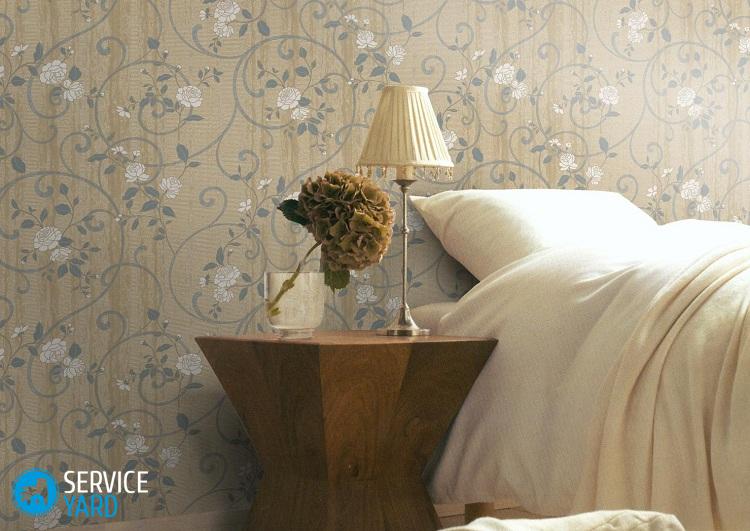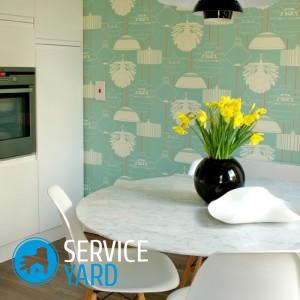What is rapport on the wallpaper?

- Varieties of drawings on the wallpaper and the rules for combining them
- What is rapport?
- How to glue wallpaper with pictures?
- How to calculate wallpaper without fitting the picture?
- How to calculate wallpaper with a fit picture?
- How to prepare the surface of the walls?
- Features of marking walls and placing large drawings
- How to glue wallpaper with a pattern without offset?
- How to glue canvases with a pattern with an offset?
- Stock footage
Many people who do not encounter wallpapering think that there is nothing complicated in this process, you just need to cut them, spread them with glue and glue them. But, unfortunately, with this approach to work, it is quite easy to spoil expensive material that has been selected for a long time, and get the result that was not planned at all. In fact, self-wallpapering has a lot of subtleties, especially when it comes to paintings with a pronounced pattern. The first step is to figure out what rapport 64 is on the wallpaper, how to cut it correctly so that the images on the adjacent stripes match. Today we’ll talk about this.
to contents ↑Varieties of drawings on the wallpaper and the rules for combining them
Images on canvases are conditionally divided into several types, which differ in appearance and principles of work with them.
Popular types of drawings:
- Solid color images. This includes canvases without pictures or a pronounced pattern, for example, polka dots, specks or with texture. They do not need to dock the basic elements, so working with them is quite simple.
- Abstract. These are stains, wide strokes, spots, which are more often arranged in a chaotic order. Such wallpapers do not need to be customized in stripes.
- Geometric. These include squares, lines, rhombuses, circles, large and small. Such wallpapers need a combination of elements.
- Stripes. As a rule, you do not need to adjust vertical stripes, but horizontal ones need to be precisely joined.
- Vegetable. They depict stems, leaves, flowers, branches. Their elements must be customized according to the patterns.
- Classic. These include monograms, which are intertwined with each other and form a single whole on the wall. In this case, docking is required.
- Ornamental - ornament, hieroglyphics, motifs of Persian carpets. The fit here depends on the nature of the images.
to contents ↑Important! Thinking over the decoration format of a room, also familiarize yourself with the ideas for designing wall decoration with such material:
What is rapport?
What does the report mean? Rapport on the wallpaper (drawing step) - repeat on one strip of images. As a rule, all information about it is on the label of each roll.
There are two types of rapport:
- In height. That is, the pattern is repeated along the entire length of the wallpaper.
- Side. Patterns are duplicated across the width of the stripes.
to contents ↑Important! If you know exactly the ratio of the height of the room and the height of the rapport, you can independently calculate how much you need to cut from each strip in order to clearly combine the picture.
How to glue wallpaper with pictures?
It is necessary to work with print wallpapers extremely carefully and attentively, because there are a lot of certain nuances. If you know all these features, then you can avoid mistakes in the form of a mismatch of the pattern.
Features wallpaper sticking with a picture:
- At the time of purchasing the material, it must be borne in mind that due to the need to combine prints, the amount of waste will increase significantly.Therefore, it is necessary to buy rolls with a margin. Knowing what the rapport of wallpaper has, you can clearly calculate the required number of tubes.
- To perfectly match the pictures, it is necessary to leave allowances on both sides of the strip a few centimeters.
- Maximum attention should be paid to the joints when gluing.
to contents ↑Important! To reduce the amount of waste, it is recommended to cut pieces from different rolls during the selection process.
How to calculate wallpaper without fitting the picture?
There are such types of paintings, for example, speckled or vertical stripes that do not need to fit images. Let's look at how the calculation is done using the example of a room that has the following parameters:
- ceiling height - 2.5 m;
- perimeter - 18 m.
Standard roll length is 10 m, width is 53 cm.
You must do the following:
- Divide the perimeter of the room by the width of the wallpaper tube to get the number of stripes. The result should be rounded up. That is, we get 34.
- Then you need to divide the length of the canvas by the height of the room, we get 4 stripes. The combination of segments will hide the skirting boards on the ceiling and floor.
- To get the right number of rolls, you should divide the first result into the second and round. As a result, we get 9 tubes.
to contents ↑Important! If wallpaper with an overlap pattern is glued, then the resulting material width must be reduced by a few centimeters.
How to calculate wallpaper with a fit picture?
Wallpaper with a large or complex ornament needs to be customized, so the calculation process will be longer. In this case, the length of the canvas should be greater than the height of the room and a multiple of rapport. Let's analyze the calculation process for a room with the same parameters (ceiling height - 2.5 m, perimeter - 18 m). A roll of 53 cm wide, 10 m long, the size of the rapport on the wallpaper will be 38 cm.
You will need to perform the calculations in the following sequence:
- The first step is to calculate the length of the strip. It is necessary to divide the height of the room by the size of the rapport, then round the resulting figure up. We will get the result 7. This indicator should be multiplied by rapport, then this result should be divided by the length of the roll. Rounding the last number is recommended in a smaller direction. We will have 3 cuts.
- Then the number of handsets is calculated. First we find the number of strips, for this divide by the width of the roll the perimeter, round. Divide the resulting figure by the number of stripes in the tube and round. That is, 12 rolls will be needed on our premises.
As you can see, the difference between the required number of wallpapers with a print without combining and pictures that need to be adjusted will be as many as 3 tubes.
to contents ↑Important! To make you comfortable not only in terms of aesthetics, but also practicality in a room with a new finish, also review the reviews:
How to prepare the surface of the walls?
Walls are prepared before gluing such wallpapers in the same way as with standard work.
The scheme of work looks like this:
- First you should clean the walls of old coatings.
- Then apply a primer coat.
- Then putty the surface in case of cracks, chips, bumps.
- The wall needs to be allowed to dry.
- Then clean with a sanding net or sandpaper.
- At the last stage, the surface is primed again.
Features of marking walls and placing large drawings
In the process of wallpapering, we often encounter ceilings and walls that have a slope.
Important! The method of marking directly depends on the level of curvature in the corners.
Follow these steps:
- First, measure the height of the room in each corner.
- If the slope is small, then take a laser level or plumb line, mark the walls to maintain a strict vertical.
- If the difference is more than 6-8 cm, then it is better to glue the wallpaper perpendicular to the ceiling, not considering the plumb line.In this case, perfectly aligned vertical stripes will look littered, thereby creating a visual surface inclination.
Important! Cloths with vertical stripes must be glued strictly on a plumb line, not taking into account the degree of curvature of the ceiling.
When the ceiling is uneven, the wallpaper with a large print should be glued so that the volumetric element of the picture is located as far as possible from the highest point of the wall. Otherwise, the curvature of the surface will immediately strike the eye. Even if you mark the pattern correctly, it may not coincide on the first and last strip due to a too curved surface. Therefore, it is better to start gluing such materials with the least visible place in the room. Do not forget to consider wallpaper rapport.
to contents ↑How to glue wallpaper with a pattern without offset?
When gluing wallpapers with images that do not need to be docked, you must follow this scheme:
- Using the previously performed calculations, cut the roll into strips so that their length coincides with the rapport step and slightly exceeds the height of the room.
- Glue the wallpaper according to the rapport. Each strip should begin with the same pattern, that is, it is necessary to select the canvas so that the images match. If you use to combine a strip from another roll, then there will be less waste.
- Thin cloths need to be glued with an overlap. Start working from the wall closest to the window so that overlaps are less noticeable.
- Position the first strip near the corner of the drawn vertical line. Next, glue the wallpaper as usual.
- As soon as you glue the opposite wall to the corner, return to the first vertical line that you used as the reference point, continue to glue from it.
How to glue canvases with a pattern with an offset?
It often happens that the details of the pictures in all the stripes on the edges do not coincide in height, therefore such wallpapers are glued with an offset image. If you use adjacent strips from the same roll, then as a result you will get just an unrealistic cost overrun. In such cases, you need to use some tricks to save material.
It is necessary to perform gluing according to the instructions:
- Take two tubes, unwind them on the floor.
- Align the canvas from the second roll with the strip from the first roll.
- Lay out the cut sheets in two piles. Due to this, the pattern on the canvas of two rolls is guaranteed to coincide.
- Glue the strips from both stacks, alternating them according to the scheme: from the first stack the first sheet, from the second stack the second sheet, from the first stack the third sheet, from the second stack the fourth sheet, and so on.
Stock footage
As you can see, wallpaper with medium or large prints that need to be combined is much more difficult to glue than plain canvases. The main disadvantage of this type of material is a large overrun. But if you carefully study the described recommendations and working methods, then you can easily cope with the sticking and save material.


















